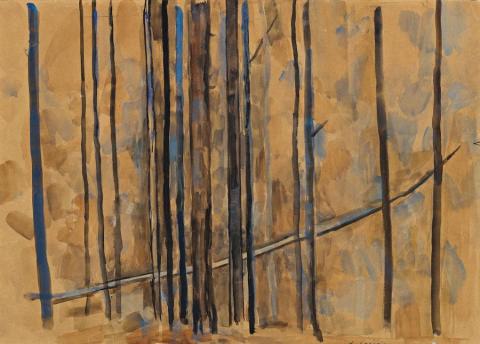FALLEN TREE, SHERBROOKE, 1959
FRED WILLIAMS
gouache and watercolour on paper on board
37.5 x 52.5 cm
signed lower right: Fred Williams
inscribed verso: No 1063 ... FRED WILLIAMS SAPLINGS
Joseph Brown Gallery, Melbourne
Private collection, Melbourne, acquired from the above in 1977
Spring Exhibition 1977: Recent Acquisitions, Joseph Brown Gallery, Melbourne, 24 October – 7 November 1977, cat. 99 (illus. in exhibition catalogue, as'Sherbrook')
In 1958, the year before Fallen Tree, Sherbrooke was painted, artist and critic Alan Warren noted that, 'Gum tree paintings of Fred Williams are something of a shock. Having borne with the successive inventions of the past three decades, it now catches us unawares to be confronted with pictures which are much closer to Cézanne than Picasso.'1
Following his return to Australia in 1956 after five years abroad, Williams's objective - to reinvent representation of the Australian landscape through depictions of the (seemingly-exhausted) gum tree and with the (seemingly-dated) tools of post-Impressionism appeared, naturally, retrograde to artists and critics alike.2 It was, 'no mean feat' to take on.3
And yet, the 'shock' that Alan Warren felt on viewing Williams's gum tree pictures (at the Australian Galleries in 1958) was at Williams's knock-out success: 'This painter has at his disposal much of the vocabulary of post- Impressionism ... but he speaks the language clearly, evenly, cleverly.' 4 In Williams's hands, patches of post-Impressionist brushwork reminiscent of Cézanne become proto-Abstract-Expressionist gestures, hovering in an animated middle-ground between the 'gestural' and 'colour-field' splinter groups that would come to define that movement.
It was at this time that circling debates in the Australian art scene over figuration versus abstraction came to a head with the formation of the Antipodean group (championing the former and detesting the latter). Many of Williams's friends were in the group - Arthur and David Boyd, Charles Blackman, John Brack, Robert Dickerson, John Perceval and Clifton Pugh - but Williams was not asked to join; art historian Bernard Smith, the chief instigator of the group and its manifesto, felt Williams's work too abstract. Williams, although hurt, and although eventually asked to join (he declined), was all the better for it; his work would only become more abstract - beginning with his eucalypt pictures.5
Williams first stayed at the house of John and Joan Stephens in Colo Vale, near Mittagong in the Southern Highlands of New South Wales in 1957. Between '58 and '61, Williams also regularly visited his friends Nance and Martin Foster at their house near Olinda, on the edge of Sherbrooke Forest in the Dandenong Ranges, just outside Melbourne.6
From these two locations we have two separate but not entirely distinct series of 'treescapes'; the Mittagong and Sherbrooke Forest series. Williams would return to both these locations to paint regularly over the years, but it is in the 1958-61 Sherbrooke pictures that the most marked shift in Williams's style is recorded; the pictures show,'Williams becoming increasingly abstract, the saplings are fairly uniform in size and their strong black outlines and the close tonality of the background form a wall with ambiguous spatial depth.'7 It is in the Sherbrooke pictures that the seeds of Williams's abstraction are sown, budding in the Sapling Forest pictures (1961-62), and bursting into textural bloom for the first time in the You Yangs landscapes (1963-64).8 It is for this reason that the Sherbrooke pictures can now be seen to mark a turning point in Williams's long and winding career.
1. Warren, A., 'A shock in gum tree paintings', The Sun, Melbourne, 15 July 1958, p. 15
2. Hart, D., 'Resurrecting the Gum Tree', in Fred Williams: Infinite Horizons, National Gallery of Australia, Canberra, 2011, p. 45
3. Ibid.
4. Warren, A., op. cit., p. 15
5. Hart, D., op. cit., p. 52
6. Ibid., pp. 48, 52
7. Lindsay, R., and Zdanowicz, I., Paintings and Gouaches, Fred Williams: Works in the National Gallery of Victoria, National Gallery of Victoria, Melbourne, 1980, p. 39
8. Ibid.
HARRIET FLAVEL
